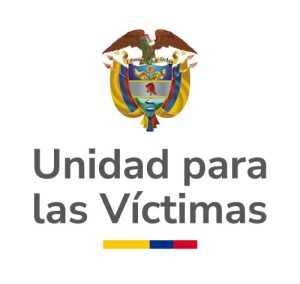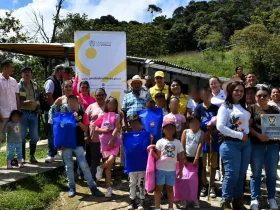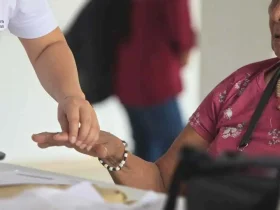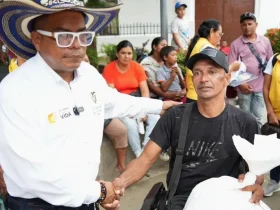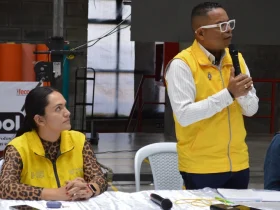By Carlos Monroy
In front of grieving relatives gathered at the ceremony, there are six coffins with skeletal remains of victims killed and disappeared by the guerrillas and self-defense groups in already confessed events; presumably, there are also victims by soldiers.
Five men and one woman were buried in mass graves and cemeteries as unidentified persons in Antioquia and Choco so they would never be found, and the crimes’ evidence could be erased.
But after several years of searching and forensic identification, the Prosecutor’s Office recovered these remains. 18 relatives, including parents, children, and siblings, received them in a court ordered event of dignify body delivery in Medellín.
Faced with this reality there were tears and pain on their faces. But it also meant relief and the end of a 21-year search for Sandra Correa. At the end of the act and holding the small brown coffin and the photograph of her brother Eladio, she felt in her soul “a sense of peace having him here. This was what I needed to rest.”
During the previous two days and at the court ordered ceremony, a psychosocial team from the Unit for the Victims supported the relatives to face this painful moment and learn about the forensic report on how they were murdered and disappeared.
With a memory workshop and the making of a loom with photos, they also dignified their absent and remembered loved ones. For Sandra, who drew two heavenly angels and wrote evocative phrases such as “good brother, good son and very happy”, this activity meant “a relief to get closure and a proper way to say goodbye, cause now he’s not lying in a hole.”
The painful reunion
The day before, and in separate rooms for each family, the first and painful reunion with their loved ones remains took place. There, forensic anthropologists opened the coffins, showed them the skeletons, and told them how they were shot to death and then disappeared. Finally, they informed them on their location and how they were identified.
The forensic specialist explained Sandra that Eladio’s remains showed several gunshot wounds, but the cause of death was a bullet he received in the forehead.
She listened carefully. But she wanted to confirm what he said, and that is why she took the skull and other bones on her own hands. At that time, the Prosecutor’s Office anthropologist referred a particular finding of a metallic fragment embedded in a hand bone.
Sandra no longer had any doubts, she nodded. Eladio died and that skeleton proved it. Leaving the room, she said that “as a child a blunderbuss accidentally fired, and a pellet ended up wounding him in the hand and the doctors were unable to remove it. I knew it and didn’t say anything to confirm it was him.”
“My brother was a 14-year-old boy when he was forcibly recruited by the 34th FARC front in Carmen de Atrato. He worked milking cows on a farm and when my father died, he took care of us and was like the little head of the household. He was incredibly happy since he was a child, and we called him little rooster because he crowed like a rooster since he started walking”.
That happy childhood and peasant life ended at the end of 2001 in his village, at a time when children and teenagers were taken from their homes, harassed in schools, or tempted with money offers by the FARC, the Guevarista Revolutionary Army and the ELN.
According to the recent Truth Commission’s Final Report, between 1990 and 2017 alone, almost 17,000 children were recruited in Colombia by illegal armed groups due to the armed conflict, while 64,084 lost their lives between 1985 and 2018 due to violence.
His victimization didn’t end with his recruitment. A few months later, after barely turning 15, Eladio died in a confrontation with the Army. According to his relatives, several inhabitants of the area where the battle took place who knew them told them about his death. “They told us he was wounded, but instead of capturing him they just finished him off, and that is why I would like an investigation and justice for him”.
The family, who had been displaced by violence, learned years later that his body had been buried in a cemetery with a guerrilla member killed in the same events, however, he was unidentified, and they didn’t know in which vault or grave.
Sandra never stopped looking for him, and she endured until she located several graves of John Does who were exhumed sometime later. Some years went by until DNA tests confirmed they had found Eladio in Carmen de Atrato’s cemetery 21 years after his death.
After recovering her brother’s remains, and thanks to psychosocial care, Sandra managed to settle a “debt” with her mother. She always believed her mother was grieving because she died without knowing if her little brother was dead or alive.”
That is why she drew two angels on the loom. She returned to her town in Choco with “the peace of mind that I am going to give my little brother to my mother, so the two of them can fly high and rest in peace”.
Renson was not spared either
Two of the six victims who were delivered to their families were minors recruited by the guerrillas in Choco. In addition to Eladio, Renson Martinez was also taken in 1999 to carry a weapon in the ranks of the Guevarista Revolutionary Army in Carmen de Atrato.
“He was the youngest at home, he was 14 and he studied. At that time, the guerrilla roamed the area as if they were law. They took more than 10 boys from the surroundings and mine fell among them,” said Gloria, his mother, the day she received his remains in a coffin at the court ordered ceremony.
From that day on, she didn’t know about his whereabouts, until months later when she found him in a settlement. She was saddened to see him wearing a uniform and a weapon, but even more so when she tried to persuade him to leave: “I told him to get out of there, but he said crying he couldn’t get out because they could kill him. They threatened all of them.”
Renson’s family lived 18 years of uncertainty, until five years ago the Prosecutor’s Office exhumed skeletal remains of several men who died in battle.
Gloria and other relatives received the Unit for the Victims’ psychosocial care and used the activities to rebuild their life on the memory loom and remember him as a “good son, a happy and loving person and a soccer player.”
They also used this to face their grief after recovering his remains and leaving for his funeral. There, his mother felt peace by giving him “the last hug and the last goodbye to my son, also knowing that he is there to visit him.”
After Eladio and Renson’s funeral in Carmen de Atrato, several families asked ex-combatants to confess the location of more graves with disappeared people.
Another of the remains delivered to his family belong to a man killed and buried in Urrao in events investigated by the Prosecutor’s Office for an alleged extrajudicial execution.
According to judicial investigators, the search for the disappeared, the exhumations and their identification revealed difficulties that persist in finding them, mainly because in many cemeteries they were buried as John Does, and the remains of different people were mixed in the graves without any classification; in this case, he had been buried in Carmen de Atrato.
Reparation and kept promises
In the Single Victims Registry, there are more than 56,000 disappeared and close to 137,000 family members recognized for the crime of forced disappearance in Colombia. In Antioquia, there are 12,490 direct victims and 33,780 indirect victims (relatives).
Sandra and Gloria are part of the 11,884 family members receiving psychosocial care as part of the exhumations and delivery ceremonies of almost 6,000 skeletal remains of the disappeared in Colombia. In addition, almost 72,000 of them have already been compensated by the Unit for the Victims with more than 520,000 million COP as integral reparation measures.
In total, the Prosecutor’s Office has exhumed more than 8,000 bodies of murdered and disappeared people in Colombia. Of these, 4,601 have already been handed over to their relatives. Another 1,732 are in the laboratories with a possible identity and another 1,827 are unidentified.
(End/JCM/COG/RAM)

